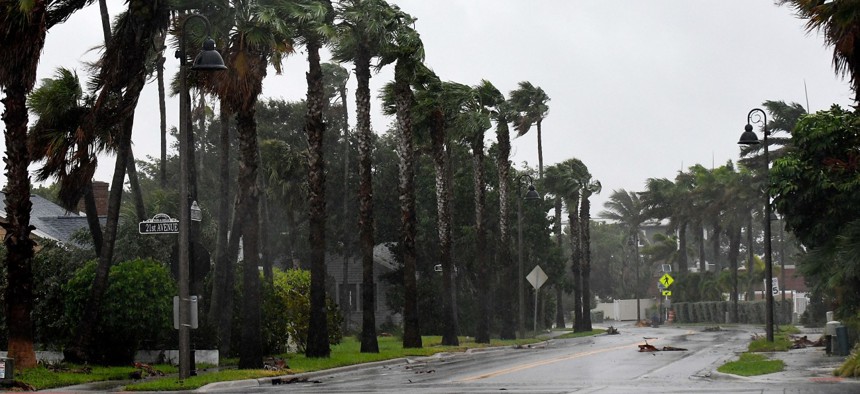
The street is empty in a neighborhood of St. Pete Beach as the winds from Hurricane Ian arrive on Wednesday. Gerardo Mora/Getty Images
Agencies Across Government Are Sending Help as Hurricane Ian Slams Florida
FEMA says it has sufficient resources to handle the potentially catastrophic storm even as it tackles several crises simultaneously.
The Biden administration is emphasizing the interagency coordination taking place to respond to Hurricane Ian as it makes landfall on Wednesday, noting it has deployed 1,300 employees to the impacted region to provide a variety of emergency services.
While the Federal Emergency Management Agency is leading the federal response to the storm that will potentially reach Category 5, the departments of Defense, Interior and Health and Human Services are also playing key on-the-ground support roles, in addition to the Homeland Security Department’s Customs and Border Protection and U.S. Coast Guard. The National Oceanic and Atmospheric Administration and U.S. Air Force have sent drones into the storm for up-to-date data, as well their own personnel—known as “hurricane hunters”—to improve forecasts.
Officials said on Wednesday they are expecting a “historic” storm with major damage that will require collaboration across all levels of government.
“This is going to be a storm we talk about for many years to come,” National Weather Service Director Ken Graham told reporters. “A historic event.”
FEMA Administrator Deanne Criswell said the federal government’s top immediate priority will be search and rescue, noting many people in Florida in Ian’s path did not have time to evacuate or opted not to do so. Criswell expects FEMA to deploy many more personnel to Florida in the next 24 hours and the subsequent days after it is able to assess the impact of the hurricane and determine where resources are needed. FEMA has 3,500 reservists ready to respond, as well as 7,500 federal employees in DHS and across government who have volunteered for the Surge Capacity Force. Congress created the force in the 2006 Post-Katrina Emergency Management Reform Act and FEMA has activated it on limited occasions for hurricane response, as well as to address upticks in migrants arriving at the southern border and for COVID-19 response.
HHS has sent dozens of employees to Florida as part of a disaster medical assistance team, with several more teams already sent to Georgia ready to deploy as needed. Criswell noted these are the same employees who HHS sent out for COVID-19 response.
FEMA is still responding to several disasters around the country, most notably in Puerto Rico where Hurricane Fiona caused significant damage. Still, Criswell insisted her workforce is not stretched too thin, nor are employees worn out from years of an unusually high number of significant natural disasters and other initiatives that required federal responders.
“We have a very talented and dedicated work staff, [a] team of emergency managers,” Criswell said. “And we have enough people right now to come in and support the response for this. And then we will work to identify what the recovery needs are once we understand what the damages are. But we are more than postured to be able to support this response.”
After being tapped for disaster and wildfire response, the influx of border crossings, the resettling of Afghan evacuees and pandemic assistance, FEMA employees sounded the alarm on their lack of down time between deployments and warned of burnout as the agency no longer experiences a true offseason. FEMA reservists have told Government Executive new hires were receiving insufficient training before deployment and some employees were working 12-hour days for a month straight. There is some optimism FEMA will soon have a better ability to retain its part-time workforce after Congress passed the Civilian Reservist Emergency Workforce Act to provide those employees who leave their day jobs to address disasters with the same protections as members of the armed forces deployed to active duty.
Graham praised the NOAA employees who track down storms and help keep the public safe.
“They’re going toward the storms so we can get everyone away from the storm,” Graham said. “Absolutely amazing work from these heroes.”
FEMA has prepositioned 128,000 gallons of fuel, 3.7 million meals, 3.5 million liters of water, hundreds of generators and 300 ambulances in Alabama and Florida so they can be disbursed as necessary. The Army Corps of Engineers has 350 personnel in the area to conduct power and fuel assessments as soon as Ian passes. The search and rescue teams, made up of staff from FEMA, CBP, Defense, Interior, USCG and the Florida government, are in Miami and will have capacity from the air, land and sea. FEMA Regional Administrator Gracia Szczech is embedded within the Florida government and hundreds of personnel are embedded within the state’s emergency management center.
“This level of interagency coordination will not stop,” Criswell said.
The administrator added that staff in the agency’s Atlanta regional office are ready to deploy. She has sent liaisons to the Georgia and South Carolina state governments to prepare for the storm’s northward movement and FEMA has already positioned resources in those states.
NEXT STORY: The COVID-19 Booster’s Public Relations Problem







